coolant temperature MERCEDES-BENZ METRIS 2020 MY20 Operator’s Manual
[x] Cancel search | Manufacturer: MERCEDES-BENZ, Model Year: 2020, Model line: METRIS, Model: MERCEDES-BENZ METRIS 2020Pages: 320, PDF Size: 26.38 MB
Page 10 of 320
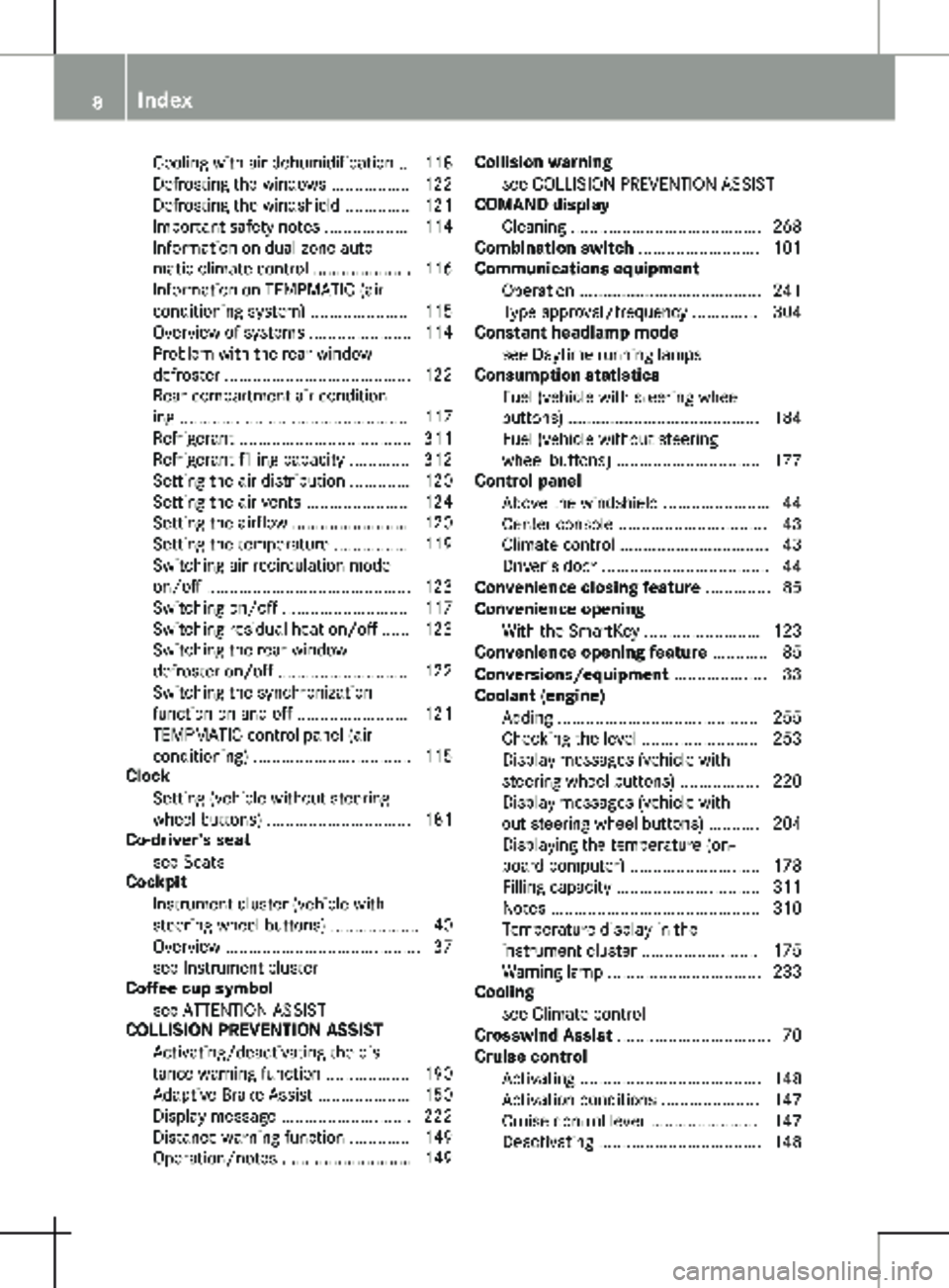
Cooling with air dehumidification .. 118
Defrosting the windows .................
122
Defrosting the windshield .............. 121
Important safety notes .................. 114
Information on dual-zone auto-
matic climate control ..................... 116
Information on TEMPMATIC (air-
conditioning system) ..................... 115
Overview of systems ...................... 114
Problem with the rear window
defroster ........................................ 122
Rear-compartment air condition-
ing ................................................. 117
Refrigerant ..................................... 311
Refrigerant filling capacity ............. 312
Setting the air distribution ............. 120
Setting the air vents ...................... 124
Setting the airflow ......................... 120
Setting the temperature ................ 119
Switching air-recirculation mode
on/off ............................................ 123
Switching on/off ........................... 117
Switching residual heat on/off ...... 123
Switching the rear window
defroster on/off ............................ 122
Switching the synchronization
function on and off ........................ 121
TEMPMATIC control panel (air
conditioning) .................................. 115
Clock
Setting (vehicle without steering
wheel buttons) ............................... 181
Co-driver's seat
see Seats
Cockpit
Instrument cluster (vehicle with
steering wheel buttons) ................... 40
Overview .......................................... 37
see Instrument cluster
Coffee cup symbol
see ATTENTION ASSIST
COLLISION PREVENTION ASSIST
Activating/deactivating the dis-
tance warning function .................. 190
Adaptive Brake Assist .................... 150
Display message ............................ 222
Distance warning function ............. 149
Operation/notes ............................ 149 Collision warning
see COLLISION PREVENTION ASSIST
COMAND display
Cleaning
......................................... 268
Combination switch .......................... 101
Communications equipment
Operation ....................................... 241
Type approval/frequency .............. 304
Constant headlamp mode
see Daytime running lamps
Consumption statistics
Fuel (vehicle with steering wheel
buttons) ......................................... 184
Fuel (vehicle without steering
wheel buttons) ............................... 177
Control panel
Above the windshield ....................... 44
Center console ................................ 43
Climate control ................................ 43
Driver's door .................................... 44
Convenience closing feature .............. 85
Convenience opening
With the SmartKey ......................... 123
Convenience opening feature ............ 85
Conversions/equipment .................... 33
Coolant (engine)
Adding ........................................... 255
Checking the level ......................... 253
Display messages (vehicle with
steering wheel buttons) ................. 220
Display messages (vehicle with-
out steering wheel buttons) ........... 204
Displaying the temperature (on-
board computer) ............................ 178
Filling capacity ............................... 311
Notes ............................................. 310
Temperature display in the
instrument cluster ......................... 175
Warning lamp ................................. 233
Cooling
see Climate control
Crosswind Assist ................................. 70
Cruise control
Activating ....................................... 148
Activation conditions ..................... 147
Cruise control lever ....................... 147
Deactivating ................................... 1488
Index
Page 18 of 320
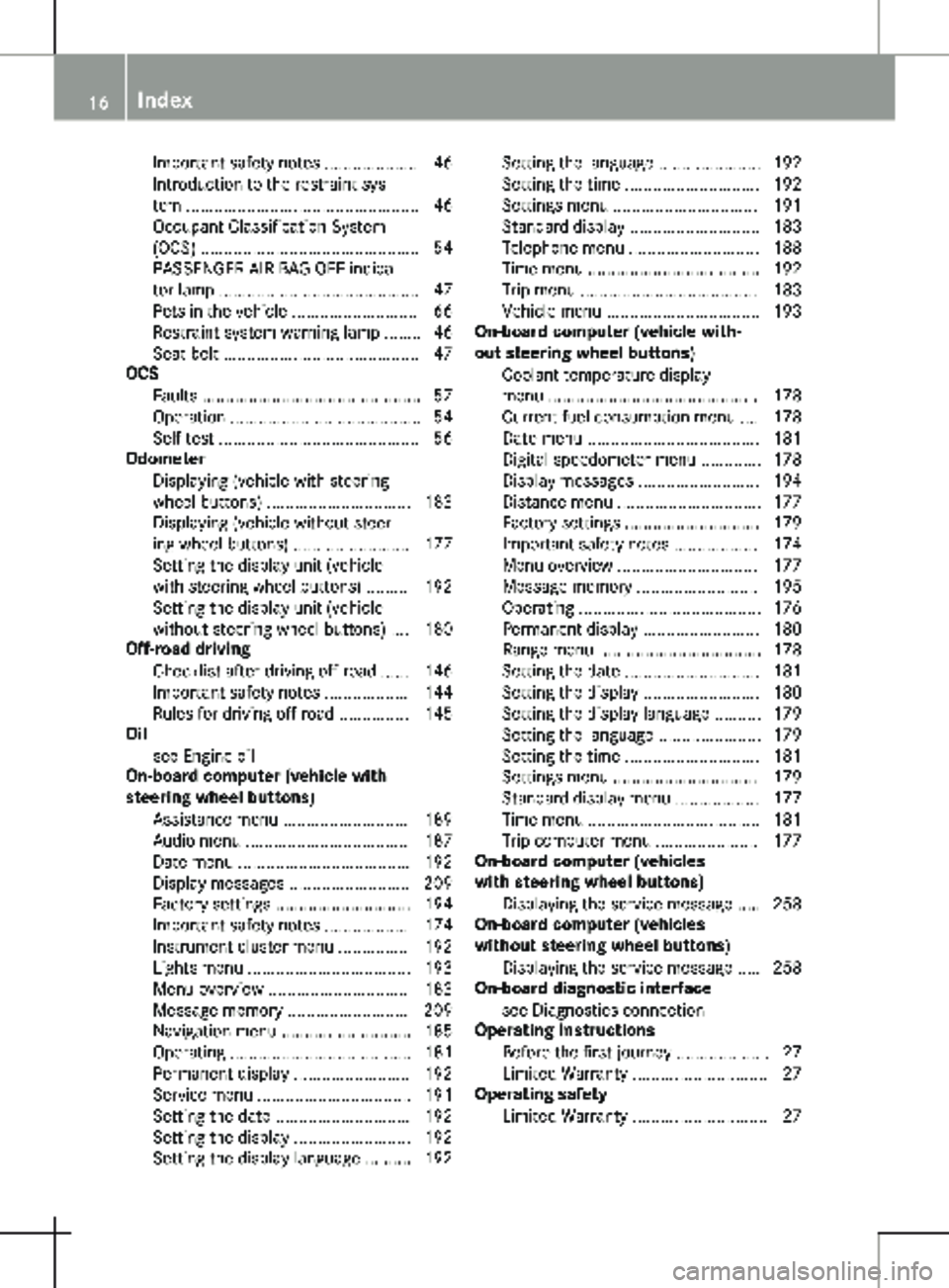
Important safety notes .................... 46
Introduction to the restraint sys-
tem ..................................................
46
Occupant Classification System
(OCS) ............................................... 54
PASSENGER AIR BAG OFF indica-
tor lamp ........................................... 47
Pets in the vehicle ........................... 66
Restraint system warning lamp ........ 46
Seat belt .......................................... 47
OCS
Faults ............................................... 57
Operation ......................................... 54
Self-test ........................................... 56
Odometer
Displaying (vehicle with steering
wheel buttons) ............................... 183
Displaying (vehicle without steer-
ing wheel buttons) ......................... 177
Setting the display unit (vehicle
with steering wheel buttons) ......... 192
Setting the display unit (vehicle
without steering wheel buttons) .... 180
Off-road driving
Checklist after driving off-road ...... 146
Important safety notes .................. 144
Rules for driving off-road ............... 145
Oil
see Engine oil
On-board computer (vehicle with
steering wheel buttons)
Assistance menu ........................... 189
Audio menu ................................... 187
Date menu ..................................... 192
Display messages .......................... 209
Factory settings ............................. 194
Important safety notes .................. 174
Instrument cluster menu ............... 192
Lights menu ................................... 193
Menu overview .............................. 183
Message memory .......................... 209
Navigation menu ............................ 185
Operating ....................................... 181
Permanent display ......................... 192
Service menu ................................. 191
Setting the date ............................. 192
Setting the display ......................... 192
Setting the display language .......... 192 Setting the language ...................... 192
Setting the time ............................. 192
Settings menu ............................... 191
Standard display ............................ 183
Telephone menu ............................ 188
Time menu ..................................... 192
Trip menu ...................................... 183
Vehicle menu ................................. 193
On-board computer (vehicle with-
out steering wheel buttons)
Coolant temperature display
menu ............................................. 178
Current fuel consumption menu .... 178
Date menu ..................................... 181
Digital speedometer menu ............. 178
Display messages .......................... 194
Distance menu ............................... 177
Factory settings ............................. 179
Important safety notes .................. 174
Menu overview .............................. 177
Message memory .......................... 195
Operating ....................................... 176
Permanent display ......................... 180
Range menu ................................... 178
Setting the date ............................. 181
Setting the display ......................... 180
Setting the display language .......... 179
Setting the language ...................... 179
Setting the time ............................. 181
Settings menu ............................... 179
Standard display menu .................. 177
Time menu ..................................... 181
Trip computer menu ...................... 177
On-board computer (vehicles
with steering wheel buttons)
Displaying the service message ..... 258
On-board computer (vehicles
without steering wheel buttons)
Displaying the service message ..... 258
On-board diagnostic interface
see Diagnostics connection
Operating Instructions
Before the first journey .................... 27
Limited Warranty ............................. 27
Operating safety
Limited Warranty ............................. 2716
Index
Page 23 of 320

Starting
see Starting (engine)
Starting (engine) ................................
128
Status overview (on-board com-
puter) .................................................. 189
Steering
Display messages (vehicle with
steering wheel buttons) ................. 227
Display messages (vehicle with-
out steering wheel buttons) ........... 208
Warning lamps ............................... 237
Steering wheel
Adjusting ......................................... 95
Button overview ............................... 42
Buttons (on-board computer) ......... 181
Cleaning ......................................... 269
Paddle shifters ............................... 135
Steering wheel paddle shifters ........ 135
Stickers
General safety notes ........................ 29
Stowage net ....................................... 239
Stowage spaces
see Stowage spaces and stow-
age compartments
Stowage spaces and stowage
compartments
Eyeglasses compartment ............... 238
Glove box ....................................... 238
Important safety notes .................. 238
Stowage net ................................... 239
Summer opening
see Convenience opening feature
Summer tires
In winter ........................................ 280
Sun visor
Changing a bulb (mirror lamp) ....... 104
Overview ........................................ 239
Surround lighting (on-board com-
puter) .................................................. 193
Switching air-recirculation mode
on/off ................................................. 123
Switching off the alarm (ATA) ............ 70T
Tachometer ........................................
175Tail lamps
Display messages (vehicle with-
out steering wheel buttons)
........... 202
Replacing bulbs ............................. 108
Trailer display messages (vehicle
with steering wheel buttons) .. 216, 217
Trailer display messages (vehicle
without steering wheel buttons) .... 202
Tailgate
Changing bulbs (ambient lamp) ..... 104
Display messages (vehicle with
steering wheel buttons) ................. 226
Display messages (vehicle with-
out steering wheel buttons) ........... 208
Important safety notes .................... 81
Opening dimensions ...................... 313
Opening/closing from the out-
side .................................................. 81
Replacing light bulbs (signal/
ambient lamp) ................................ 105
Tank
see Fuel tank
Tank contents
Displaying the range (vehicle
with steering wheel buttons) ......... 184
Displaying the range (vehicle
without steering wheel buttons) .... 178
Technical data
Capacities ...................................... 305
Cargo tie-down points .................... 313
Guide rail ....................................... 314
Loading rails .................................. 314
Roof carrier .................................... 314
Tires/wheels ................................. 301
Trailer tow hitch ............................. 315
Vehicle data ................................... 312
Vehicle dimensions ........................ 313
Telephone
Accepting a call ............................. 188
Display message ............................ 227
Introduction ................................... 188
Number from the phone book ........ 188
Redialing ........................................ 189
Rejecting/ending a call ................. 188
Temperature
Coolant (display in the instru-
ment cluster) ................................. 175 Index
21
Page 24 of 320

Coolant (display in the on-board
computer) ......................................
178
Outside temperature ...................... 175
Setting (climate control) ................ 119
Theft deterrent systems
ATA (Anti-Theft Alarm system) ......... 70
Immobilizer ...................................... 70
Time
Setting (vehicle with steering
wheel buttons) ............................... 192
Setting the time (vehicle with
steering wheel buttons) ................. 192
Setting the time (vehicle without
steering wheel buttons) ................. 181
Tire pressure
Calling up (on-board computer) ..... 285
Checking manually ........................ 285
Display messages (vehicle with
steering wheel buttons) ................. 224
Display messages (vehicle with-
out steering wheel buttons) ........... 207
Maximum ....................................... 285
Notes ............................................. 284
Recommended ............................... 282
Tables ............................................ 289
Tire label ........................................ 282
Tire pressure monitor
Checking the tire pressure elec-
tronically ........................................ 287
Function/notes ............................. 285
General notes ................................ 285
Important safety notes .................. 286
Restarting ...................................... 288
Warning lamp ................................. 236
Warning message .......................... 287
Tire pressure table ............................ 289
Tires
Aspect ratio (definition) ................. 296
Average weight of the vehicle
occupants (definition) .................... 295
Bar (definition) ............................... 295
Changing a wheel .......................... 297
Characteristics .............................. 295
Checking ........................................ 279
Curb weight (definition) ................. 296
Definition of terms ......................... 295
Direction of rotation ...................... 297 Display messages (vehicle with
steering wheel buttons) .................
224
Display messages (vehicle with-
out steering wheel buttons) ........... 207
Distribution of the vehicle occu-
pants (definition) ............................ 297
DOT (Department of Transporta-
tion) (definition) ............................. 295
DOT, Tire Identification Number
(TIN) ............................................... 294
GAWR (Gross Axle Weight Rat-
ing) (definition) .............................. 296
GTW (Gross Trailer Weight) (defi-
nition) ............................................ 296
GVW (Gross Vehicle Weight) (def-
inition) ........................................... 296
GVWR (Gross Vehicle Weight
Rating) (definition) ......................... 296
Important safety notes .................. 278
Increased vehicle weight due to
optional equipment (definition) ...... 295
Information on driving .................... 278
Kilopascal (kPa) (definition) ........... 296
Labeling (overview) ........................ 292
Load bearing index (definition) ...... 297
Load index ..................................... 294
Load index (definition) ................... 296
M+S tires ....................................... 280
Maximum load on a tire (defini-
tion) ............................................... 296
Maximum loaded vehicle weight
(definition) ..................................... 296
Maximum permissible tire pres-
sure (definition) ............................. 296
Maximum tire load ......................... 294
Maximum tire load (definition) ....... 296
Optional equipment weight (defi-
nition) ............................................ 297
PSI (pounds per square inch)
(definition) ..................................... 296
Replacing ....................................... 297
Service life ..................................... 279
Sidewall (definition) ....................... 297
Snow chains .................................. 281
Speed rating (definition) ................ 296
Storing ........................................... 298
Structure and characteristics
(definition) ..................................... 295 22
Index
Page 40 of 320
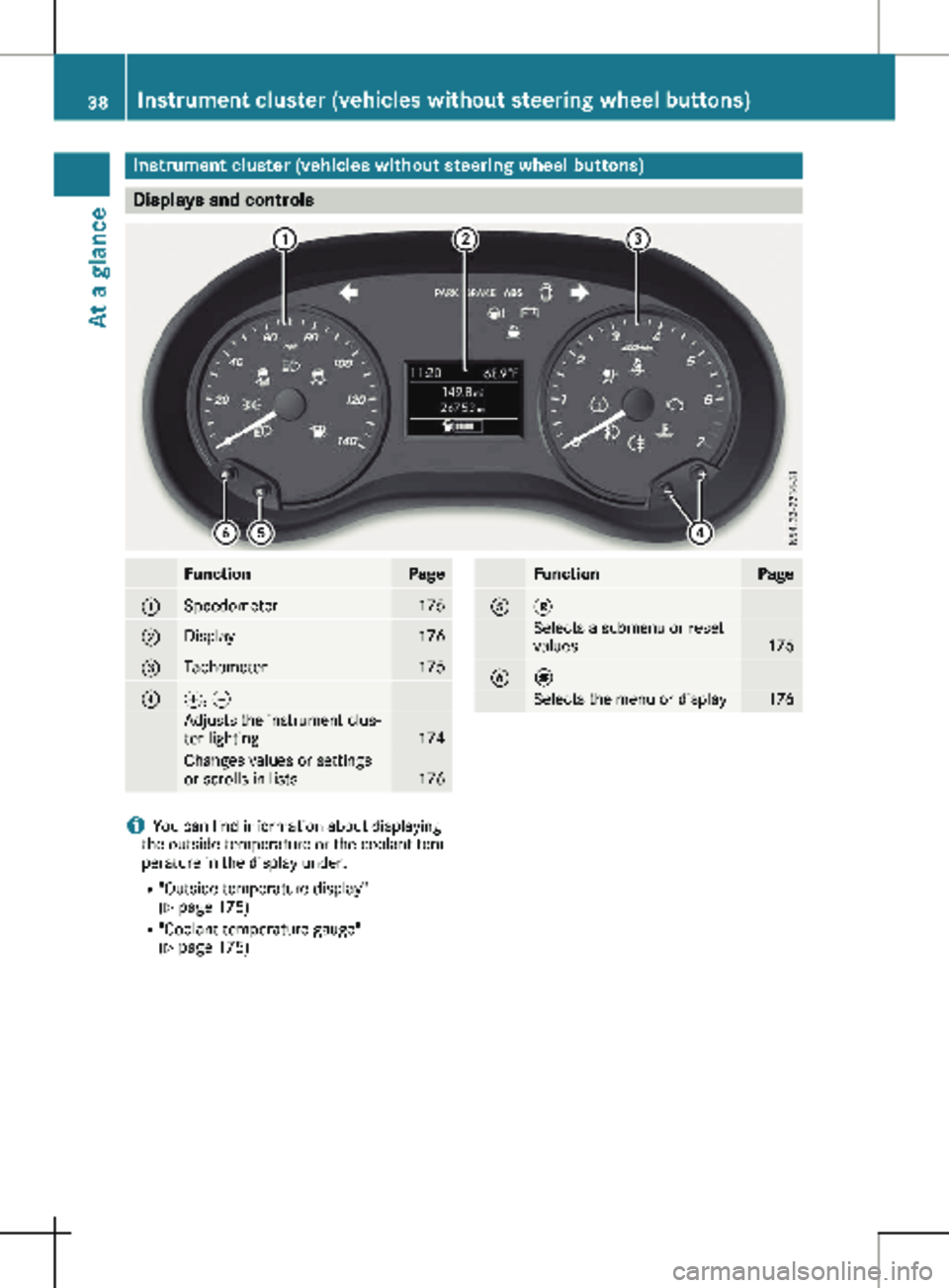
Instrument cluster (vehicles without steering wheel buttons)
Displays and controls
Function Page
:
Speedometer 175
;
Display 176
=
Tachometer 175
?
f, g
Adjusts the instrument clus-
ter lighting
174
Changes values or settings
or scrolls in lists
176 Function Page
A 3
Selects a submenu or reset
values
176
B È
Selects the menu or display 176
i
You can find information about displaying
the outside temperature or the coolant tem-
perature in the display under:
R "Outside temperature display"
(Y page
175)
R "Coolant temperature gauge"
(Y page 175)38
Instrument cluster (vehicles without steering wheel buttons)
At a glance
Page 42 of 320
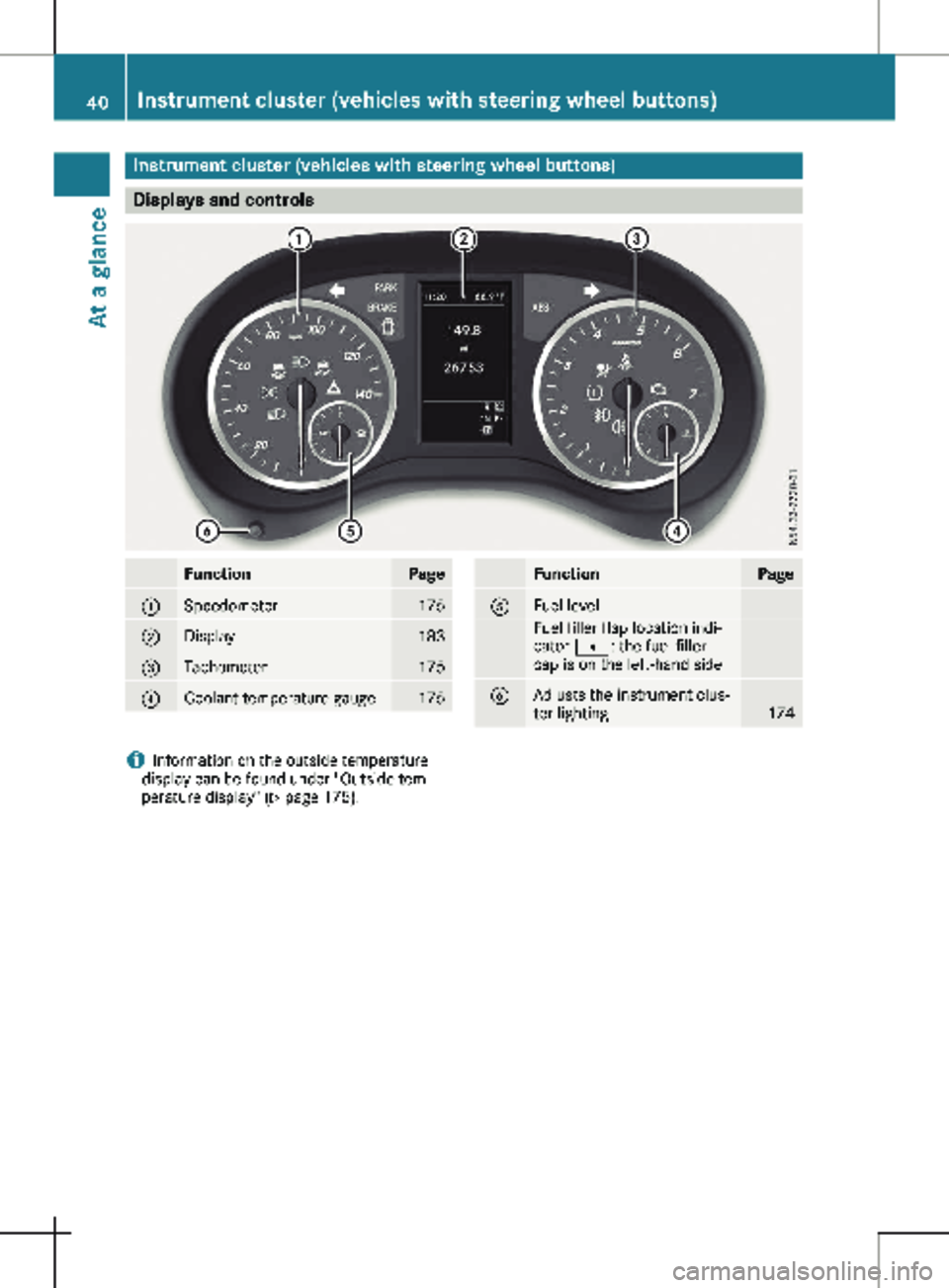
Instrument cluster (vehicles with steering wheel buttons)
Displays and controls
Function Page
:
Speedometer 175
;
Display 183
=
Tachometer 175
?
Coolant temperature gauge 175 Function Page
A
Fuel level
Fuel filler flap location indi-
cator t: the fuel filler
cap is on the left-hand side
B
Adjusts the instrument clus-
ter lighting
174
i
Information on the outside temperature
display can be found under "Outside tem-
perature display"
(Y page 175). 40
Instrument cluster (vehicles with steering wheel buttons)
At a glance
Page 127 of 320
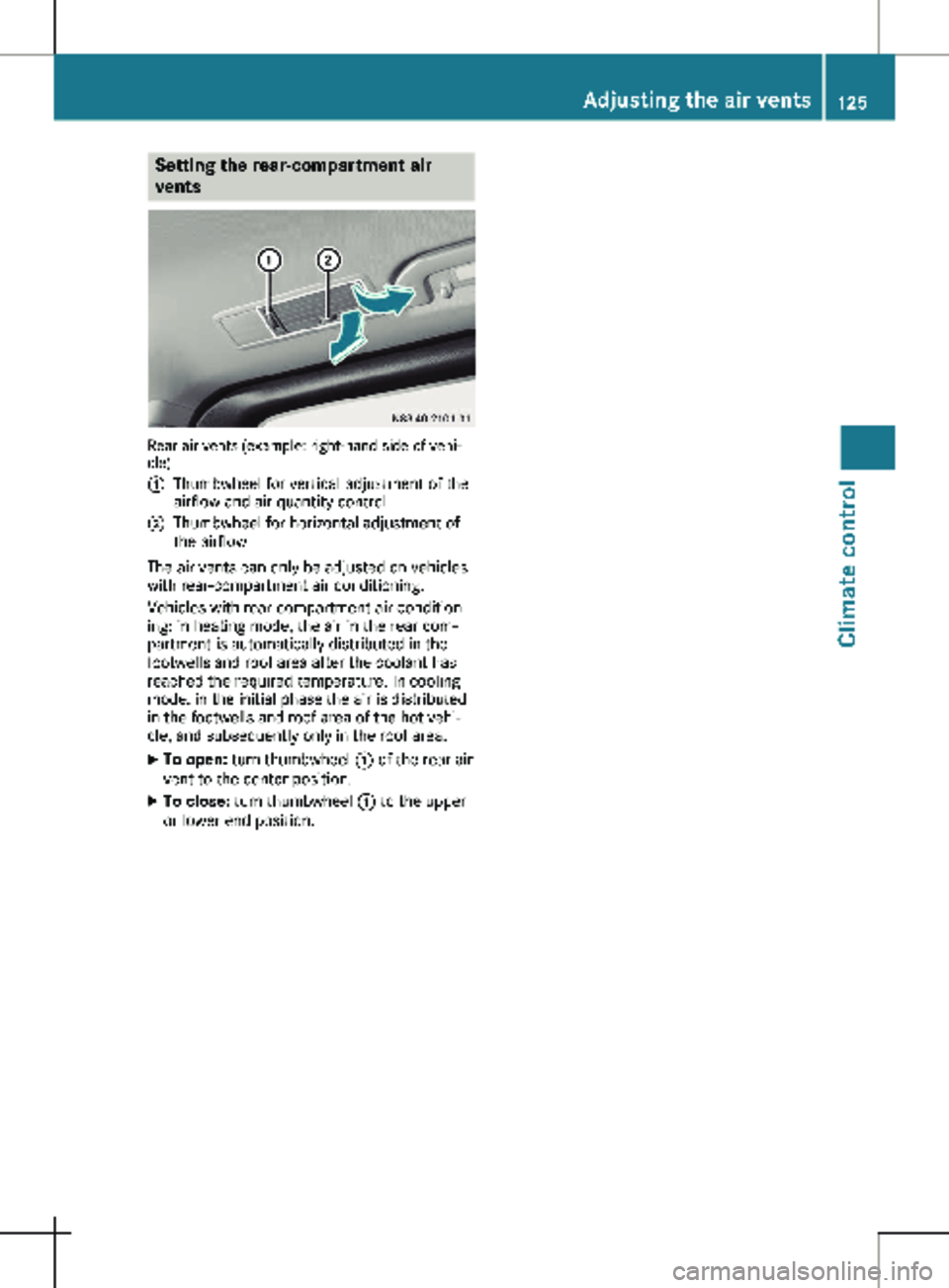
Setting the rear-compartment air
vents
Rear air vents (example: right-hand side of vehi-
cle)
:
Thumbwheel for vertical adjustment of the
airflow and air quantity control
; Thumbwheel for horizontal adjustment of
the airflow
The air vents can only be adjusted on vehicles
with rear-compartment air conditioning.
Vehicles with rear-compartment air condition-
ing: in heating mode, the air in the rear com-
partment is automatically distributed in the
footwells and roof area after the coolant has
reached the required temperature. In cooling
mode, in the initial phase the air is distributed
in the footwells and roof area of the hot vehi-
cle, and subsequently only in the roof area.
X To open: turn thumbwheel : of the rear air
vent to the center position.
X To close: turn thumbwheel : to the upper
or lower end position. Adjusting the air vents
125Climate control Z
Page 141 of 320
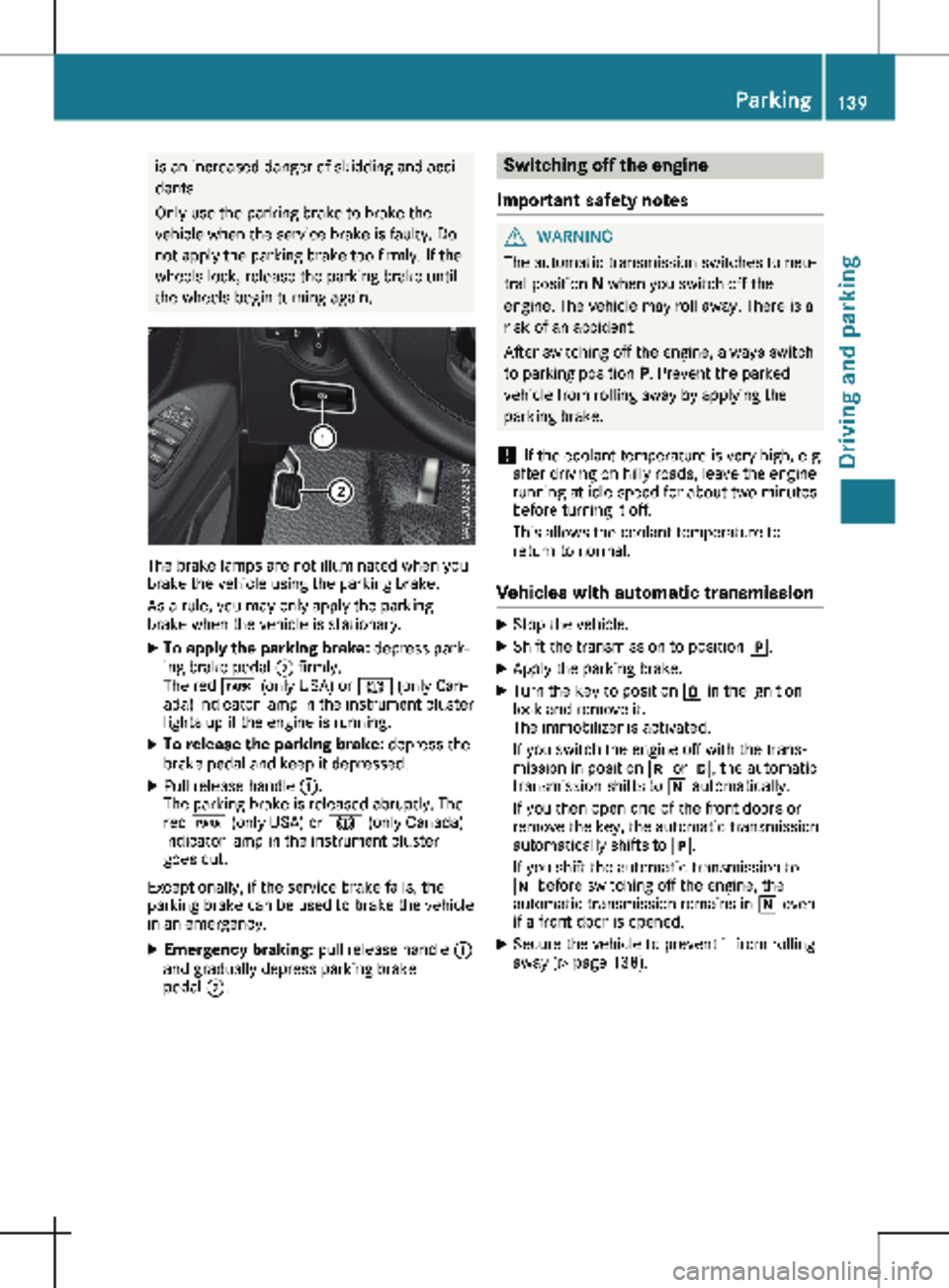
is an increased danger of skidding and acci-
dents.
Only use the parking brake to brake the
vehicle when the service brake is faulty. Do
not apply the parking brake too firmly. If the
wheels lock, release the parking brake until
the wheels begin turning again. The brake lamps are not illuminated when you
brake the vehicle using the parking brake.
As a rule, you may only apply the parking
brake when the vehicle is stationary.
X To apply the parking brake: depress park-
ing brake pedal ; firmly.
The red F (only USA) or J (only Can-
ada) indicator lamp in the instrument cluster
lights up if the engine is running.
X To release the parking brake: depress the
brake pedal and keep it depressed.
X Pull release handle :.
The parking brake is released abruptly. The
red F (only USA) or J (only Canada)
indicator lamp in the instrument cluster
goes out.
Exceptionally, if the service brake fails, the
parking brake can be used to brake the vehicle
in an emergency.
X Emergency braking: pull release handle :
and gradually depress parking brake
pedal ;. Switching off the engine
Important safety notes G
WARNING
The automatic transmission switches to neu-
tral position N when you switch off the
engine. The vehicle may roll away. There is a
risk of an accident.
After switching off the engine, always switch
to parking position P. Prevent the parked
vehicle from rolling away by applying the
parking brake.
! If the coolant temperature is very high, e.g.
after driving on hilly roads, leave the engine
running at idle speed for about
two minutes
before turning it off.
This allows the coolant temperature to
return to normal.
Vehicles with automatic transmission X
Stop the vehicle.
X Shift the transmission to position j.
X Apply the parking brake.
X Turn the key to position u in the ignition
lock and remove it.
The immobilizer is activated.
If you switch the engine off with the trans-
mission in position k or h, the automatic
transmission shifts to i automatically.
If you then open one of the front doors or
remove the key, the automatic transmission
automatically shifts to j.
If you shift the automatic transmission to
i before switching off the engine, the
automatic transmission remains in i even
if a front door is opened.
X Secure the vehicle to prevent it from rolling
away
(Y page 138). Parking
139
Driving and parking Z
Page 173 of 320
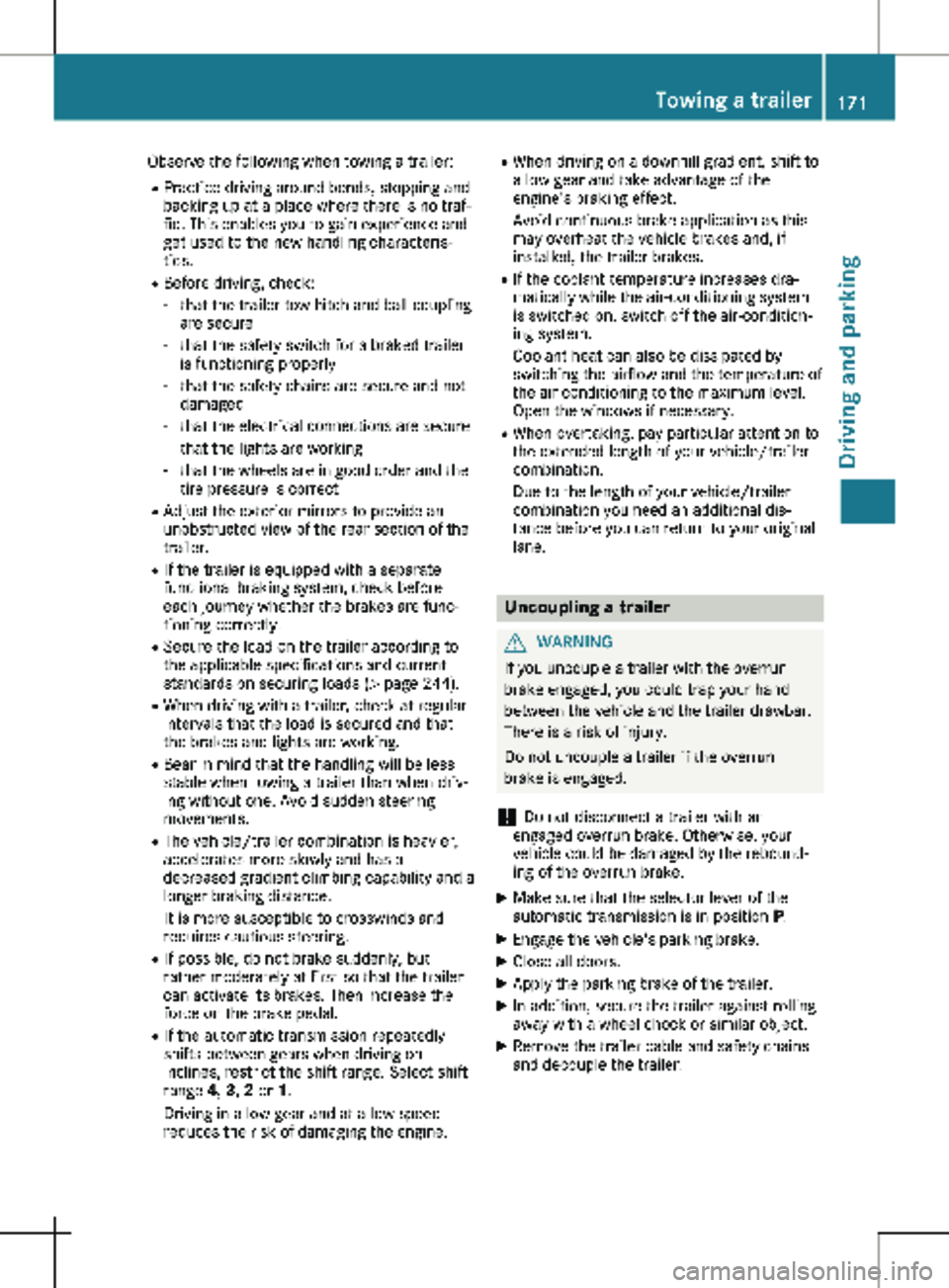
Observe the following when towing a trailer:
R Practice driving around bends, stopping and
backing up at a place where there is no traf-
fic. This enables you to gain experience and
get used to the new handling characteris-
tics.
R Before driving, check:
- that the trailer tow hitch and ball coupling
are secure
- that the safety switch for a braked trailer
is functioning properly
- that the safety chains are secure and not
damaged
- that the electrical connections are secure
- that the lights are working
- that the wheels are in good order and the
tire pressure is correct
R Adjust the exterior mirrors to provide an
unobstructed view of the rear section of the
trailer.
R If the trailer is equipped with a separate
functional braking system, check before
each journey whether the brakes are func-
tioning correctly.
R Secure the load on the trailer according to
the applicable specifications and current
standards on securing loads
(Y page 244).
R When driving with a trailer, check at regular
intervals that the load is secured and that
the brakes and lights are working.
R Bear in mind that the handling will be less
stable when towing a trailer than when driv-
ing without one. Avoid sudden steering
movements.
R The vehicle/trailer combination is heavier,
accelerates more slowly and has a
decreased gradient climbing capability and a
longer braking distance.
It is more susceptible to crosswinds and
requires cautious steering.
R If possible, do not brake suddenly, but
rather moderately at first so that the trailer
can activate its brakes. Then increase the
force on the brake pedal.
R If the automatic transmission repeatedly
shifts between gears when driving on
inclines, restrict the shift range. Select shift
range 4, 3, 2 or 1.
Driving in a low gear and at a low speed
reduces the risk of damaging the engine. R
When driving on a downhill gradient, shift to
a low gear and take advantage of the
engine's braking effect.
Avoid continuous brake application as this
may overheat the vehicle brakes and, if
installed, the trailer brakes.
R If the coolant temperature increases dra-
matically while the air-conditioning system
is switched on, switch off the air-condition-
ing system.
Coolant heat can also be dissipated by
switching the airflow and the temperature of
the air conditioning to the maximum level.
Open the windows if necessary.
R When overtaking, pay particular attention to
the extended length of your vehicle/trailer
combination.
Due to the length of your vehicle/trailer
combination you need an additional dis-
tance before you can return to your original
lane. Uncoupling a trailer
G
WARNING
If you uncouple a trailer with the overrun
brake engaged, you could trap your hand
between the vehicle and the trailer drawbar.
There is a risk of injury.
Do not uncouple a trailer if the overrun
brake is engaged.
! Do not disconnect a trailer with an
engaged overrun brake. Otherwise, your
vehicle could be damaged by the rebound-
ing of the overrun brake.
X Make sure that the selector lever of the
automatic transmission is in position P.
X Engage the vehicle's parking brake.
X Close all doors.
X Apply the parking brake of the trailer.
X In addition, secure the trailer against rolling
away with a wheel chock or similar object.
X Remove the trailer cable and safety chains
and decouple the trailer. Towing a trailer
171
Driving and parking Z
Page 177 of 320

In daylight, the displays in the instrument clus-
ter are illuminated. A dimming function is not
possible in daylight.
On vehicles with steering wheel buttons, the
light sensor in the instrument cluster automat-
ically controls the brightness of the display
lighting.
While the lights are on, the brightness is
dependent upon the brightness of the ambient
light. You can also adjust the brightness of the
instrument lighting and the display lighting:
R by pressing the f and g buttons on the
instrument cluster on vehicles without
steering wheel buttons (not in the Settings
menu)
R by turning brightness control knob : on
vehicles with steering wheel buttons Speedometer
If you change the wheel size on your vehicle,
make sure it is assigned to the correct wheel
size category ( Y page
278). If you change
wheel size category without recoding the con-
trol unit, the speedometer indication will be
inaccurate. The current vehicle speed may
then be higher than the speed displayed in the
speedometer.
The speed can also be shown in the display in
the form of a digital speedometer:
R on vehicles without steering wheel buttons
(Y page 178)
R on vehicles with steering wheel buttons
(Y page 185)
i In some countries, a warning sounds
and/or the display shows a message when
the vehicle reaches the maximum legally
permissible speed limit, e.g. at 75 mph
(120 km/h). Tachometer
! Do not drive in the overrevving range, as
this could damage the engine. H
Environmental note
Avoid driving at high engine speeds. This
unnecessarily increases the fuel consump-
tion of your vehicle and harms the environ-
ment as a result of increased emissions. The red band in the tachometer indicates the
engine's overrevving range.
To protect the engine, the fuel supply is inter-
rupted when the red band is reached.
Outside temperature display
You should pay special attention to road con-
ditions when temperatures are around freezing
point.
Please bear in mind that the outside tempera-
ture display shows the air temperature meas-
ured and not the road temperature.
The display shows the outside temperature in
the header:
R on vehicles without steering wheel buttons
(Y page
176)
R on vehicles with steering wheel buttons
(Y page 183)
Changes in the outside temperature are dis-
played after a short delay. Coolant temperature gauge
G
WARNING
Opening the hood when the engine is over-
heated or when there is a fire in the engine
compartment could expose you to hot gases
or other service products. There is a risk of
injury.
Let an overheated engine cool down before
opening the hood. If there is a fire in the
engine compartment, keep the hood closed
and contact the fire department.
On vehicles without steering wheel buttons,
you can have the coolant temperature shown
in the display
(Y page 178).
On vehicles with steering wheel buttons, an
analog coolant temperature gauge is located
in the tachometer in the instrument cluster
(Y page 40). Under normal driving conditions and at the
correct coolant level, the display may rise to
the letter H or to the red mark. Display and operation
175
On-board computer and displays Z